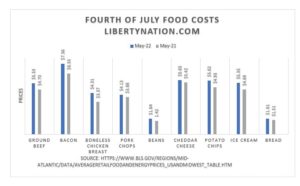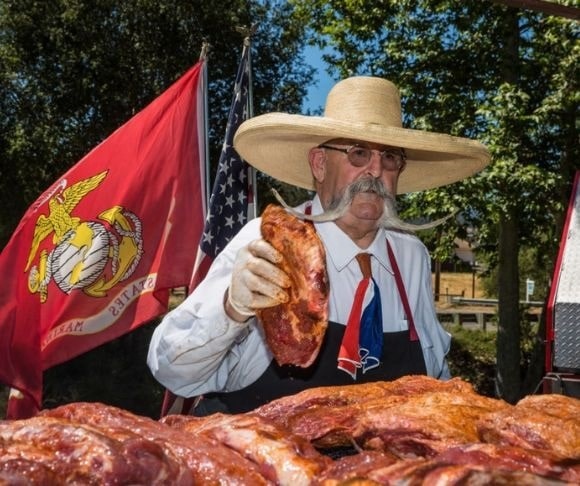
(Photo by George Rose/Getty Images)
Last year, the White House was ebullient over the news that the cost of a Fourth of July cookout was down a measly 16 cents from the same time in the previous year. This is the same administration that ran a victory lap because gasoline prices dipped by a nickel or two over a two-week period in late 2021. So, now that high inflation is entrenched in every sector of the US economy, how much will Americans spend on a good old-fashioned barbecue as they salute Old Glory?
O Say, Can You See High Prices
 Food inflation has soared 10.1% over the last year, according to the latest data from the Bureau of Labor Statistics (BLS). Every item in a refrigerator or pantry has gone up significantly, from cookies (+12.6%) to eggs (+32.2%) and lettuce (11.4%). This sticker shock might as well make every US household breatharian or heed the advice of the World Economic Forum (WEF) and start eating bugs to survive.
Food inflation has soared 10.1% over the last year, according to the latest data from the Bureau of Labor Statistics (BLS). Every item in a refrigerator or pantry has gone up significantly, from cookies (+12.6%) to eggs (+32.2%) and lettuce (11.4%). This sticker shock might as well make every US household breatharian or heed the advice of the World Economic Forum (WEF) and start eating bugs to survive.
It is not only shoppers who are feeling the agony of higher prices. Farmers are afflicted with the price-point pain, too, says Farm Bureau Chief Economist Roger Cryan:
“Despite higher food prices, the supply chain disruptions and inflation have made farm supplies more expensive; like consumers, farmers are price-takers not price-makers. Bottom line, in many cases the higher prices farmers are being paid aren’t covering the increase in their farm expenses. The cost of fuel is up and fertilizer prices have tripled.”
So what about the annual summer cookout? These estimates might vary from the yearly American Farm Bureau (AFB) report, but, based on the BLS numbers from May, here is how much families can expect to spend on this year’s Fourth of July festivities.
- Ground Beef: +13.4% to $5.332 per pound
- Bacon: +16% to $7.364 per pound
- Boneless Chicken Breast: +27.9% to $4.31 per pound
- Pork Chops: +6.6% to $4.13 per pound
- Beans: +15.5% to $1.64 per pound
- Cheddar Cheese: +4.1% to $5.645 per pound
- Potato Chips: +14% to $5.619 per 16 ounce
- Ice Cream: +14.2% to $5.352 half gallon
- Bread: +6.3% to $1.606 per pound
 Will the 2023 Fourth of July parties be cheaper? It depends. On the one hand, many suppliers and chain restaurants warn that prices will keep climbing as energy costs soar, and supply chains remain fractured. On the other, investment research firm Morningstar forecasts it will begin next year as multiple agricultural commodities have weakened significantly in recent sessions: wheat, corn, and soybeans are down 9%, 16%, and 15%, respectively.
Will the 2023 Fourth of July parties be cheaper? It depends. On the one hand, many suppliers and chain restaurants warn that prices will keep climbing as energy costs soar, and supply chains remain fractured. On the other, investment research firm Morningstar forecasts it will begin next year as multiple agricultural commodities have weakened significantly in recent sessions: wheat, corn, and soybeans are down 9%, 16%, and 15%, respectively.
Whatever the case may be, Alan Blinder, professor of economics and public affairs at Princeton and former vice chairman of the Fed, does not believe inflation will be a permanent phenomenon. “One day, hopefully soon, food and energy prices will level off and the supply chain problems will dissipate,” he wrote in a recent op-ed in The Wall Street Journal. “Inflation will fall as quickly and dramatically as it rose. We’ve seen it happen before.”
Until then, households will feel hunger pangs as many consumers skip meals or reduce their portions.
Getting to the July 4 Party Will Be Expensive

(Photo by George Rose/Getty Images)
While hosting a Fourth of July barbecue will be expensive, even attending one will be a costly endeavor. The national average for a gallon of gasoline is up 58.22% from the same time a year ago, hovering around $4.90. Of course, pain at the pump is felt differently throughout the country, with motorists in California paying $6.31 and Georgia forking over $4.40 to gasoline stations. Transporting meat and produce has added to food prices. An average gallon of diesel has skyrocketed 79% to around $5.80.
Fasting on the Fourth
Since food inflation is eating a significant chunk of household budgets, perhaps fasting on the Fourth is the only solution. Consumers are exhausting their savings, taking on more debt, driving less, and imbibing an entire bottle of Pepto Bismol every time the US government releases the latest inflation data. Maybe this year will be a more solemn event as the cost of living metastasizes into a crisis and the federal government tortures the public with the consequences of Keynesian interventionist economics. The state of the country is hard to swallow.
Remember to check out the web’s best conservative news aggregator
Whatfinger.com — the #1 Alternative to the Drudge


